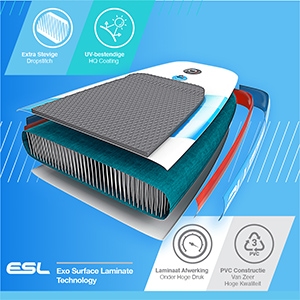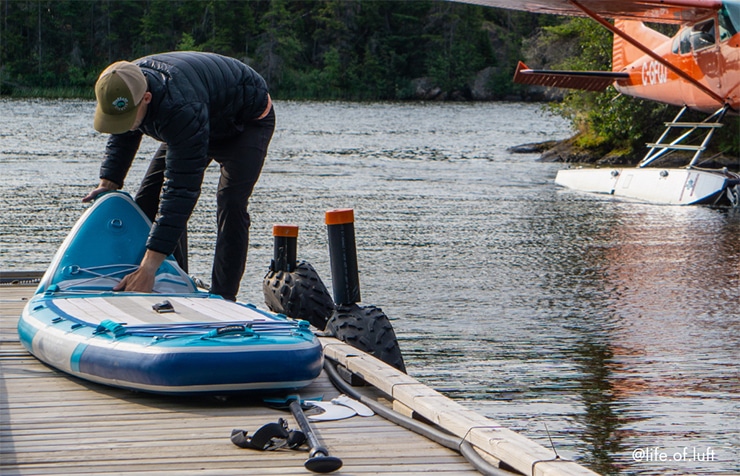How long do inflatable paddle boards last? This is one of the most common questions about inflatable SUPs.
Blow-up paddle boards have many advantages, the main one being portability and ease of storage. They are also much more durable than hard paddle boards and you may have seen the incredible durability tests like the one below.
But they’re not totally indestructible and you are probably wondering when you can expect to replace your iSUP or start dealing with repairs.
Inflatable paddle boards can last anywhere from a couple of years to many years, depending on several factors.
RELATED: Read our reviews of your 10 best iSUP options in 2024.
Factors That Affect the Durability of an Inflatable Paddle Board
One inflatable paddle board can last for decades while another one may start coming apart after a few seasons. Why is that?
1. SUP Construction

Inflatable boards are built using drop stitch construction at the core and a layer or more of PVC material. The quality of materials and technology used varies from manufacturer to manufacturer.
Companies like Red Paddle Co. use advanced construction processes, which is why they have no problem offering a five-year warranty. As you can imagine, Red Paddle SUPs last a long time and can take a serious beating.
You can’t say the same about a $300 paddle board. For a SUP board to be that cheap, the company had to cut a few corners in production and this affects durability.
Let’s take a closer look.
a. Number of Layers
One of the things that determine a paddle board’s longevity is the number of layers. SUPs built using multiple layers of PVC are more likely to last longer than single-layer boards.
A dual-, triple-, or quad-layer PVC paddle board is stronger and harder to puncture.
The quality of the layers and the technology used to apply them matter as well. Two higher-quality PVC layers will last longer than more layers of low-quality PVCs and a machine-laminated PVC layer SUP is lighter and stiffer than a glued PVC layer SUP.
b. Seam Style
There have been cases of inflatable paddle boards bursting at the seams when left in the sun for too long. While seam glue does a good job of holding the materials together, it weakens over time.
To make the SUPs last longer, companies now opt for a mechanically-welded seam. Bluefin SUP boards, for instance, have heat-welded double-side rails which eliminate the risk of bursting.
c. UV Protection
UV rays are not good for your inflatable SUP, and it’s not just because they can make the colors fade. The sun can make even the military-grade materials used to build your SUP deteriorate over time.
A high-quality inflatable paddle board should have a UV coating to protect it from UV ray damage.
Note that you need to keep reapplying the UV coat throughout the board’s lifetime.
2. Paddle Board Maintenance

Another determining factor of an inflatable paddle board’s durability is maintenance. Like everything else you own, you have to take good care of your SUP to make it last longer.
Inflatable paddle boards are built to do what hard boards can’t. You can paddle a rocky river with your iSUP and it will easily bounce off the rocks.
But just because inflatable boards can take heavy use and abuse doesn’t mean that they don’t need care. If you treat your inflatable SUP poorly, the materials will degrade faster and it may not last.
So, what is the proper maintenance routine of an iSUP?
How to Take Care of Your Inflatable SUP to Make It Last Longer
There are things you should do (and things you should avoid) when it comes to caring for your inflatable stand up paddle board. Here are a few things you can do to keep your board in good condition for a long time.
a. Clean the Inflatable Board Properly
Rinse your inflatable paddle board with fresh water after every paddling session, especially if you paddle in saltwater. You want to rinse off all the salt water, sand, and other debris. If you notice stubborn dirt use a soft cloth and mild cleaner.
b. Let Your iSUP Dry
Your inflatable SUP should be completely dry before you store it to prevent the growth of mold. Wait for the paddle board to dry, roll it up nicely, and put it in its storage bag.
It is better to towel dry the board if you’re in a hurry than to store it wet.
c. Keep Your iSUP Away from the Sun

Don’t leave your SUP under direct sunlight, and this applies to a hard paddle board as well. The sun will degrade pretty much anything and that includes your paddle board.
[h4] d. Should You Store It Inflated?
It is okay to store your paddle board inflated. Some people may even encourage it because it won’t crease as a result of being folded. You should, however, release a little pressure before storing to leave room for the air inside to expand.
If the iSUP is fully inflated and temperatures rise, the air inside will expand causing the seams to be under extreme pressure. This weakens them and if the inflatable is poorly made it can burst.
When storing your inflatable SUP for a long period, you should consider deflating it.
e. Don’t Drag Your Inflatable Paddle Board!
Most paddle boards can survive being run over by a car but even a good quality inflatable paddle board has its limits.
Dragging your inflatable board will quickly wear it out. If you accidentally drag it over a sharp object the damage could be unrepairable.
f. Fix Damage To Your iSUP Immediately
Always repair damages immediately instead of waiting until they get worse. Inflatable paddle boards are easy to fix and they even come with a repair kit in the package. If you hear a hissing sound get out of the water and repair the leak.

YOU MAY ALSO LIKE: How much are paddle boards?
Wrapping Up
Inflatable paddle boards can last anywhere from a few years to a lifetime. A more expensive SUP from a reputable company is likely to last longer because of the construction and material quality.
How you take care of your paddle board will also determine its longevity. Rinse your iSUP with fresh water after every use and let it dry completely before storage. Don’t leave your paddle board under the sun for too long and always repair a leak as soon as you notice it.
If you have a question please feel free to leave a comment below.
Happy paddling!

